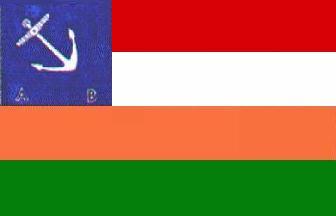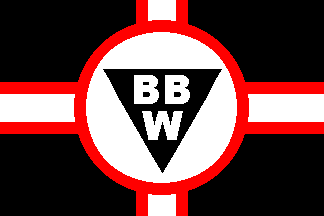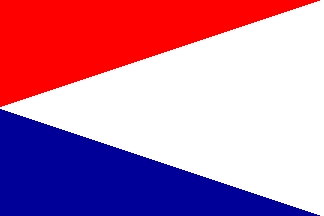Our History Flags
South Africa
      |
|---|
 |
 |
 |
| Natalia |
|---|
Natalia was the "Voortrekker" state in Natal which was established after the Voortrekkers arrived there in 1838 and deposed the Zulu king Dingane in 1840. The state was occupied by the British and annexed in 1843. Their flag was horizontally red over blue, divided by a white triangle from hoist (base) to fly (apex) and was used between 1839-1843The description you have is incorrect (as is the description by Cresham Carr). The apex of the triangle is actually at the hoist. The image needs to be inverted 90 degrees as at the moment it is as if the hoist is on the right hand side inside. |
Klip River Republic |
| I notice that you have a link from a reference to "Klip River Republic" under this heading to the Klipdrift Republic, one of the two diggers' states. Firstly, the Klip River Republic was in the north of the Colony of Natal (as it was before the incorporation of Zululand).  It was more or less a remnant of the Republiek van Natalia and was eliminated by the firm establishment of British authority in Durban and Pietermaritzburg, and extending from there to the colony's borders between the Thukela, Buffalo and Mzimkhulu rivers and the Drakensberg mountain range. The burghers either became British subjects or trekked away elsewhere. (This Klip River is a short tributary to the Thukela, lying upriver from Ladysmith. There are other rivers elsewhere in South Africa with the same name). |
|
|---|
|
I think that the fact that the country was named after the Orange River (itself named after the Dutch royal house) must have had a bearing and that the canton and stripes design is likely a reference to the Stars and Stripes, which inspired other "new" nations' flags in this period (e.g. Greece, El Salvador) |
|
This flag was registered with the South African Bureau of Heraldry as the flag of the Republic of Orange Free State for the Office of the Prime Minister, together with the flag of the South African Republic, on 30 April 1983 (application 08 January 1982, amendment 05 March 1982). Certificates were issued for both in Afrikaans on 14 October 1983. |
|
The text in English for the flag Republic of Orange Free State reads as follows: |
Following the Union of South Africa , that is the joining of the former colonies of Natal, Cape, Transvaal and Orange River on 31 May 1910, South Africa used defaced red and blue ensigns. Having suffered defeat in the Anglo-Boer War (1899-1902), many South Africans particularly of Boer extraction found these flags unacceptable. Discussions about a new flag had taken place from time to time but were interrupted by such pressing issues as World War I and achieving Dominion Status within the British Empire etc. and it was only in 1925 that the matter began to receive renewed attention.
|
|---|
| The issue of inclusion of the Union Jack proved to be a very emotional subject, with the English-speakers on the one side demanding its inclusion and the Afrikaners (Boers) seeing its a symbol of British imperialism demanding it be excluded! A number of proposals were put forward but it was not until the Prinzenvlag design based on the House of Orange that consensus began to emerge. This design was based on the commonly held view that Jan van Riebeeck has raised an orange, white and blue horizontal tricolour when he arrived at the Cape in April 1652. The original design had a quartered shield in the centre, each quarter having a symbol to represent the territories making up the Union. Various other designs were submitted to a Parliamentary Committee which had been established to resolve the issue but none found favour. |
|
The compromise design eventually adopted saw the flag of the Republic of the Orange Free State hanging vertically in the centre of the white stripe of the Prinzenvlag with the Union Jack spread horizontally towards the hoist from the centre and the flag of the Zuid-Afrikaansche Republiek (Transvaal) spread towards the fly. In terms of the Union Nationality and Flags Act of 1927 South Africa had two flags, namely the Union Jack to denote association with the British Commonwealth of Nations and a national flag described as being: |
| "Three horizontal stripes of equal width from top to bottom, orange, white, blue; in the centre of the white stripe the old Orange Free State Flag hanging vertically, spread in full, with the Union Jack adjoining horizontally, spread in full, towards the pole, and the old Transvaal Vierkleur adjoining horizontally spread in full away from the pole, equidistant from the margins of the white stripe. The flags shall be of the same size and their shape shall be proportionally the same as the National Flag and the width of each equal to one-third of the width of the white stripe". This Act came into force on 31 May 1928 when both the new national flag and the Union Jack were hoisted together for the first time at simultaneous ceremonies at the Houses of Parliament in Cape Town and at the Union Buildings in Pretoria. The flags first hoisted at Parliament are now on display in the Old Assembly chamber. |
|
In December 1880 rebellious Boers again declared a South African Republic, which re-established the "Vierkleur". This is the war flag of the former South African Republic (Transvaal), used during the Anglo-Boer War (1899-1902). |
|---|
| The "vierkleur" (4 colour) design was first used by the Boer Republic of Land Goshen (Republiek van Land Goshen) between 1881-84 where the vertical stripe was green and the horizontal stripes were black, white and red. This was followed by the New Republic (Nieuwe Republiek) between 1884-88 whose flag had a blue vertical stripe and red, white and green horizontal stripes. The Zuid-Afrikaanse Republiek (ZAR/Transvaal) flew the now traditional "vierkleur" of a green vertical stripe and red, white and blue horizontal stripes between 1858-1902. The green in the flag stands for hope and youthfulness. |
|
The use of red, white and blue, and indeed of the unadulterated Dutch tricolour Boer flags. |
|
The Vierkleur of the Zuid-Afrikaansche Republiek was designed by Reverend Dirk van der Hoff and was hoisted for the first time in Potchefstroom on 06 January 1857.
|
Republic in the Transvaal, formed between 1857 and 1864. Horizontally red-white-blue with a vertical green stripe at the hoist (known as the "Vierkleur" or four colour) 1857-1902, except for 1874-75 when the Voortrekker flag, but with the saltire fimbriated white, was restored.
|
|---|
|
In October 1874 the Volksraad adopted a new flag based on the "Voortrekker flag" for the ZAR, with the the red saltire being fimbriated in white. However, the Volksraad later reversed its decision in May 1875 when President Burgers, who was not satisfied with the vierkleur flag, was away overseas!
|
|
The flag of the ZAR was incorporated into the new South African flag in 1928 while its arms were retained as the provincial arms of the Transvaal in 1951.This flag was registered with the South African Bureau of Heraldry as the flag of the South African Republic for the Office of the Prime Minister together with the flag of the Republic of Orange Free State on 30 April 1983 (application 08 January 1982, amendment 05 March 1982). Certificates were issued for both in Afrikaans on 14 October 1983. |
|
The Vierkleur of the Zuid-Afrikaansche Republiek was designed by Reverend Dirk van der Hoff and was hoisted for the first time in Potchefstroom on 06 January 1857. It was officially accepted by the Volksraad (House of Assembly) as the flag of the ZAR on 18 February 1858. Following the occupation by the British, the flag was removed but was raised again on the Day of the Vow (Geloftedag) (16 December) in 1880 in Heidelberg. The Transvalers fought under this flag between 1899 and 1902 during the Anglo-Boer War. |
|
The Combined Republican Flag of the Anglo Boer War has an orange stripe added under the entire "vierkleur" (the so called "vyfkleur" - 5 colours). |
|---|
| In Burger's 'Sovereign Flags of Southern Africa', (1997) [bur97] are two 'vyfkleuren' (five-colours). The combined Boer armies sometimes used flags combining their colors. This flag was probably displayed by the Transvaal forces: the 'Vierkleur' (four colour) with an orange bar across the bottom. Used around 1899-1901 |
   The Vyfkleur |
   Battle of Paardeberg (1900) |
|
According to my 'Allers Illustrerede Konversations-Leksikon', the battle began on 17 and ended on 27 February 1900, when the Boer General Cronje, with 3700 soldiers, surrendered to the British General Roberts. |
|---|
   Maritz war flag |
   Hindon's war flag |
   "Unity" flags : Steyn's flag |
Boere Weerstandsbeweging (BWB) first flagThis was the flag of Boere Weersdandsbeweging (BWB) (Boer Resistance Movement in English) which was black with white cross fimbrated red; in the center of the cross is a white circle fimbrated red with three black "7"s. The BWB was initially led by Eddie von Maltitz and subsequently by Andrew Ford. (I don’t know if this organisation still exists).
|
|---|
   Boere Weerstandsbeweging (BWB) second flag |
|
When Andrew Ford took over the leadership the flag was replaced by a similar one instead of having the three 7s, bears the letters BWB in white arranged in a triangular fashion (pointing downwards) on a similarly directed black triangle. |
|
|
|
|
|---|
|
|
|
|
























 When the Republic of Orange Free State came into being on 23 February 1854 it possessed neither arms nor a flag. On 15 May 1854 the Orange Free State Government Secretary wrote to the Republic's Consul in the Netherlands and asked whether King William III would be willing to grant the OFS arms and a flag. This was followed by a personal letter to the King from President Hoffman on 15 October 1854. In February 1855, Hoffman's presidency came to an end and there followed an inter-regnum of 6 months when JN Boshoff was President. He knew nothing of the approach to the Dutch monarch.
When the Republic of Orange Free State came into being on 23 February 1854 it possessed neither arms nor a flag. On 15 May 1854 the Orange Free State Government Secretary wrote to the Republic's Consul in the Netherlands and asked whether King William III would be willing to grant the OFS arms and a flag. This was followed by a personal letter to the King from President Hoffman on 15 October 1854. In February 1855, Hoffman's presidency came to an end and there followed an inter-regnum of 6 months when JN Boshoff was President. He knew nothing of the approach to the Dutch monarch.







































